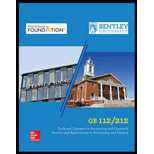
Computing Comparative Financial Statements and DuPont Ratios (AP13-6)
Use the data given in P13-5 for Prince Company.
Required:
- 1. Compute component percentages for Year 2.
- 2. Compute the ratios in the DuPont model for Year 2.
1)
Compute the Component percentage for the year 2.
Explanation of Solution
Component percentage analysis:
Component percentage analysis is prepared to analyse the relationship among various items of the financial statements with a particular base amount. This analysis is also called as common-size statement.
Compute the component percentage for the Year 2.
| Corporation P | ||
| Income Statement | ||
| For the year ended Year 2 | ||
| Particulars | Year 2 | |
| Amount | Percent | |
| ( $) | (%) | |
| Sales revenues | 190,000 | 100 |
| Cost of goods sold | 112,000 | 58.95 |
| Gross profit on sales | 78,000 | 41.05 |
| Operating expenses | 56,000 | 29.47 |
| Pre-tax income | 22,000 | 11.58 |
| Income tax expense | 8,000 | 4.21 |
| Net income | 14,000 | 7.37 |
Table (1)
| Corporation P | ||
| Balance Sheet | ||
| As on date of Year 2 end | ||
| Particulars | 2013 | |
|
Amount ( $) |
Percent (%) | |
| Cash | 4,000 | 3.88 |
| Accounts receivable | 14,000 | 13.59 |
| Inventory | 40,000 | 38.83 |
| Property and equipment | 45,000 | 43.69 |
| Total assets | 103,000 | 100.00 |
| Current liabilities | 16,000 | 15.53 |
| Long-term liabilities | 45,000 | 43.69 |
| Common stock ($5 par value) | 30,000 | 29.13 |
| Retained earnings | 12,000 | 11.65 |
| Total liabilities and owners’ equity | 103,000 | 100.00 |
Table (2)
In the income statement, base amount is sales revenue. In the balance sheet, base amount is total assets.
2)
Compute the ratios in the DuPont model for Year 2.
Explanation of Solution
DuPont model:
It is a model which allows the analyst to analyse a company’s performance using ratios. This model uses the ratios which indicates the company performance. DuPont model equiation is as follows:
Calculate the ratios in the DuPont model for Year 2.
| Ratio | Formula | Calculation | Result | ||
| 1 | Return on Equity (ROE) | 36.36% | |||
| 2 | Return on Assets (ROA) |  | 14.00% | ||
| 3 | Total asset turnover | 1.90 | |||
| 4 | Net profit margin | 7.37% | |||
| 5 | Financial leverage | 2.60 | |||
Table (3)
Working notes:
Calculate the average total stockholders’ equity
Average common stock for the year 2
Average retained earnings for theYear 2:
Average total stockholders’ equity for the Year 2:
Want to see more full solutions like this?
Chapter 13 Solutions
GB 112/212 MANAGERIAL ACC. W/ACCESS >C<
- I need help with this general accounting question using standard accounting techniques.arrow_forwardCan you help me solve this general accounting problem using the correct accounting process?arrow_forwardCan you help me solve this general accounting question using the correct accounting procedures?arrow_forward
- Can you help me solve this general accounting problem using the correct accounting process?arrow_forwardI am searching for the correct answer to this general accounting problem with proper accounting rules.arrow_forwardI need help with this general accounting question using the proper accounting approach.arrow_forward
 Excel Applications for Accounting PrinciplesAccountingISBN:9781111581565Author:Gaylord N. SmithPublisher:Cengage LearningCentury 21 Accounting Multicolumn JournalAccountingISBN:9781337679503Author:GilbertsonPublisher:Cengage
Excel Applications for Accounting PrinciplesAccountingISBN:9781111581565Author:Gaylord N. SmithPublisher:Cengage LearningCentury 21 Accounting Multicolumn JournalAccountingISBN:9781337679503Author:GilbertsonPublisher:Cengage Managerial AccountingAccountingISBN:9781337912020Author:Carl Warren, Ph.d. Cma William B. TaylerPublisher:South-Western College Pub
Managerial AccountingAccountingISBN:9781337912020Author:Carl Warren, Ph.d. Cma William B. TaylerPublisher:South-Western College Pub Intermediate Financial Management (MindTap Course...FinanceISBN:9781337395083Author:Eugene F. Brigham, Phillip R. DavesPublisher:Cengage LearningPrinciples of Accounting Volume 1AccountingISBN:9781947172685Author:OpenStaxPublisher:OpenStax College
Intermediate Financial Management (MindTap Course...FinanceISBN:9781337395083Author:Eugene F. Brigham, Phillip R. DavesPublisher:Cengage LearningPrinciples of Accounting Volume 1AccountingISBN:9781947172685Author:OpenStaxPublisher:OpenStax College





